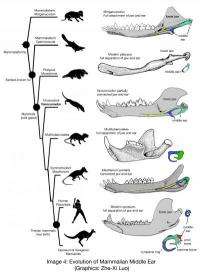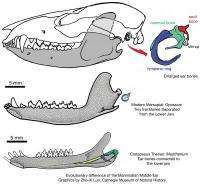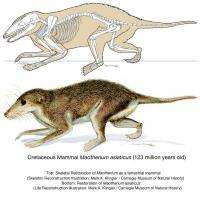Paleontologists discover a new Mesozoic mammal

Pittsburgh, Pennsylvania, USA…An international team of paleontologists has discovered a new species of mammal that lived 123 million years ago in what is now the Liaoning Province in northeastern China. The newly discovered animal, Maotherium asiaticus, comes from famous fossil-rich beds of the Yixian Formation. This new remarkably well preserved fossil, as reported in the October 9 issue of the prestigious journal Science, offers an important insight into how the mammalian middle ear evolved. The discoveries of such exquisite dinosaur-age mammals from China provide developmental biologists and paleontologists with evidence of how developmental mechanisms have impacted the morphological (body-structure) evolution of the earliest mammals and sheds light on how complex structures can arise in evolution because of changes in developmental pathways.
"What is most surprising, and thus scientifically interesting, is this animal's ear," says Dr. Zhe-Xi Luo, curator of vertebrate paleontology and associate director of science and research at Carnegie Museum of Natural History. "Mammals have highly sensitive hearing, far better than the hearing capacity of all other vertebrates, and hearing is fundamental to the mammalian way of life. The mammalian ear evolution is important for understanding the origins of key mammalian adaptations."
Thanks to their intricate middle ear structure, mammals (including humans) have more sensitive hearing, discerning a wider range of sounds than other vertebrates. This sensitive hearing was a crucial adaptation, allowing mammals to be active in the darkness of the night and to survive in the dinosaur-dominated Mesozoic.

Mammalian hearing adaptation is made possible by a sophisticated middle ear of three tiny bones, known as the hammer (malleus), the anvil (incus), and the stirrup (stapes), plus a bony ring for the eardrum (tympanic membrane). These mammal middle ear bones evolved from the bones of the jaw hinge in their reptilian relatives. Paleontologists have long attempted to understand the evolutionary pathway via which these precursor jawbones became separated from the jaw and moved into the middle ear of modern mammals.
To evolutionary biologists, an understanding of how the sophisticated and highly sensitive mammalian ear evolved may illuminate how a new and complex structure transforms through evolution. According to the Chinese and American scientists who studied this new mammal, the middle ear bones of Maotherium are partly similar to those of modern mammals; but Maotherium's middle ear has an unusual connection to the lower jaw that is unlike that of adult modern mammals. This middle ear connection, also known as the ossified Meckel's cartilage, resembles the embryonic condition of living mammals and the primitive middle ear of pre-mammalian ancestors.
Because Maotherium asiaticus is preserved three-dimensionally, paleontologists were able to reconstruct how the middle ear attached to the jaw. This can be a new evolutionary feature. Or, it can be interpreted as having a "secondarily reversal to the ancestral condition," meaning that the adaptation is the caused by changes in development. (See graphics of mammalian ear evolution, as represented by Maotherium).

Modern developmental biology has shown that developmental genes and their gene network can trigger the development of unusual middle ear structures, such as "re-appearance" of the Meckel's cartilage in modern mice. The middle ear morphology in fossil mammal Maotherium of the Cretaceous (145-65 million years ago) is very similar to the mutant morphology in the middle ear of the mice with mutant genes. The scientific team studying the fossil suggests that the unusual middle ear structure, such as the ossified Meckel's cartilage, is actually the manifestation of developmental gene mutations in the deep times of Mesozoic mammal evolution.
Maotherium asiaticus is a symmetrodont, meaning that it has teeth with symmetrically arranged cusps specialized for feeding on insects and worms. It lived on the ground and had a body 15 cm (5 inches) long and weighing approximately 70 to 80 grams (.15 to .17 lbs). By studying all features in this exquisitely preserved fossil, researchers believe Maotherium to be more closely related to marsupials and placentals than to monotremes—primitive egg-laying mammals of Australia and New Guinea such as the platypus.
Source: Carnegie Museum of Natural History

















